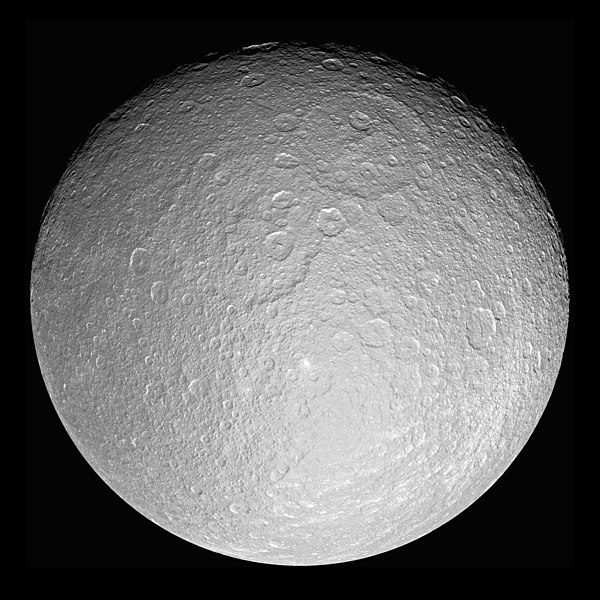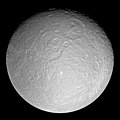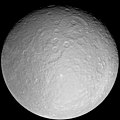Íomhá:PIA07763 Rhea full globe5.jpg

Size of this preview: 600 × 600 picteilín. Other resolutions: 240 × 240 picteilín | 480 × 480 picteilín | 768 × 768 picteilín | 1,024 × 1,024 picteilín | 2,048 × 2,048 picteilín | 4,920 × 4,920 picteilín.
Taispeáin leagan ardtaifigh den íomhá (4,920 × 4,920 picteilín, méid comhaid: 2.67 MB, cineál MIME: image/jpeg)
Stair chomhaid
Cliceáil ar dáta/am chun an comhad a radharc mar a bhí sé ag an am sin.
| Dáta/Am | Mionsamhail | Toisí | Úsáideoir | Nóta tráchta | |
|---|---|---|---|---|---|
| faoi láthair | 07:15, 27 Lúnasa 2018 |  | 4,920 × 4,920 (2.67 MB) | PlanetUser | Reverted to version as of 08:13, 13 March 2015 (UTC) |
| 10:09, 15 Lúnasa 2018 |  | 4,920 × 4,920 (2.66 MB) | The NMI User | Reverted to version as of 23:49, 14 August 2018 (UTC) | |
| 23:59, 14 Lúnasa 2018 |  | 4,920 × 4,920 (2.64 MB) | The NMI User | rv, fixed | |
| 23:49, 14 Lúnasa 2018 |  | 4,920 × 4,920 (2.66 MB) | The NMI User | Try making black | |
| 23:44, 14 Lúnasa 2018 |  | 4,920 × 4,920 (2.65 MB) | The NMI User | Fixed | |
| 08:09, 13 Lúnasa 2018 |  | 4,920 × 4,920 (3.67 MB) | The NMI User | Removing black borders | |
| 08:01, 13 Lúnasa 2018 |  | 4,920 × 4,920 (2.67 MB) | The NMI User | Reverted to version as of 08:13, 13 March 2015 (UTC) | |
| 07:56, 13 Lúnasa 2018 |  | 4,920 × 4,920 (5.67 MB) | The NMI User | Black background | |
| 08:13, 13 Márta 2015 |  | 4,920 × 4,920 (2.67 MB) | MoreTomorrow | making square (to match other planet/moon images) | |
| 06:43, 30 Deireadh Fómhair 2008 |  | 4,920 × 4,820 (2.68 MB) | WolfmanSF | This is the same full-resolution NASA image, with black panels added to the margins and some Photoshop processing to enhance contrast. |
Úsáid comhaid
Tá nasc chuig an gcomhad seo ar na leathanaigh seo a leanas:
Global file usage
The following other wikis use this file:
- Úsáid ar af.wiki.x.io
- Úsáid ar ar.wiki.x.io
- ريا (قمر)
- قالب:المجموعة الشمسية
- قائمة أجرام المجموعة الشمسية مرتبة حسب الحجم
- قائمة الأجرام المستديرة بالجاذبية في المجموعة الشمسية
- قائمة الأقمار الطبيعية
- خط زمني لاكتشاف كواكب المجموعة الشمسية وأقمارها
- اكتشاف واستكشاف النظام الشمسي
- قائمة أنواع الكواكب
- قائمة أكبر الفوهات في المجموعة الشمسية
- 1981 ميداس
- Úsáid ar ary.wiki.x.io
- Úsáid ar arz.wiki.x.io
- Úsáid ar ast.wiki.x.io
- Úsáid ar as.wiki.x.io
- Úsáid ar azb.wiki.x.io
- Úsáid ar be.wiki.x.io
- Úsáid ar bh.wiki.x.io
- Úsáid ar ca.wiki.x.io
- Úsáid ar ckb.wiki.x.io
- Úsáid ar cy.wiki.x.io
- Úsáid ar de.wiki.x.io
- Úsáid ar el.wiki.x.io
- Úsáid ar en.wiki.x.io
- Pioneer 11
- Rhea (moon)
- Cassini–Huygens
- Timeline of discovery of Solar System planets and their moons
- List of geological features on Rhea
- Naming of moons
- List of natural satellites
- List of gravitationally rounded objects of the Solar System
- Wikipedia:WikiProject Astronomy/Recognized content
- Portal:Solar System/Selected picture
- User:Dabomb87/Sandbox
View more global usage of this file.


